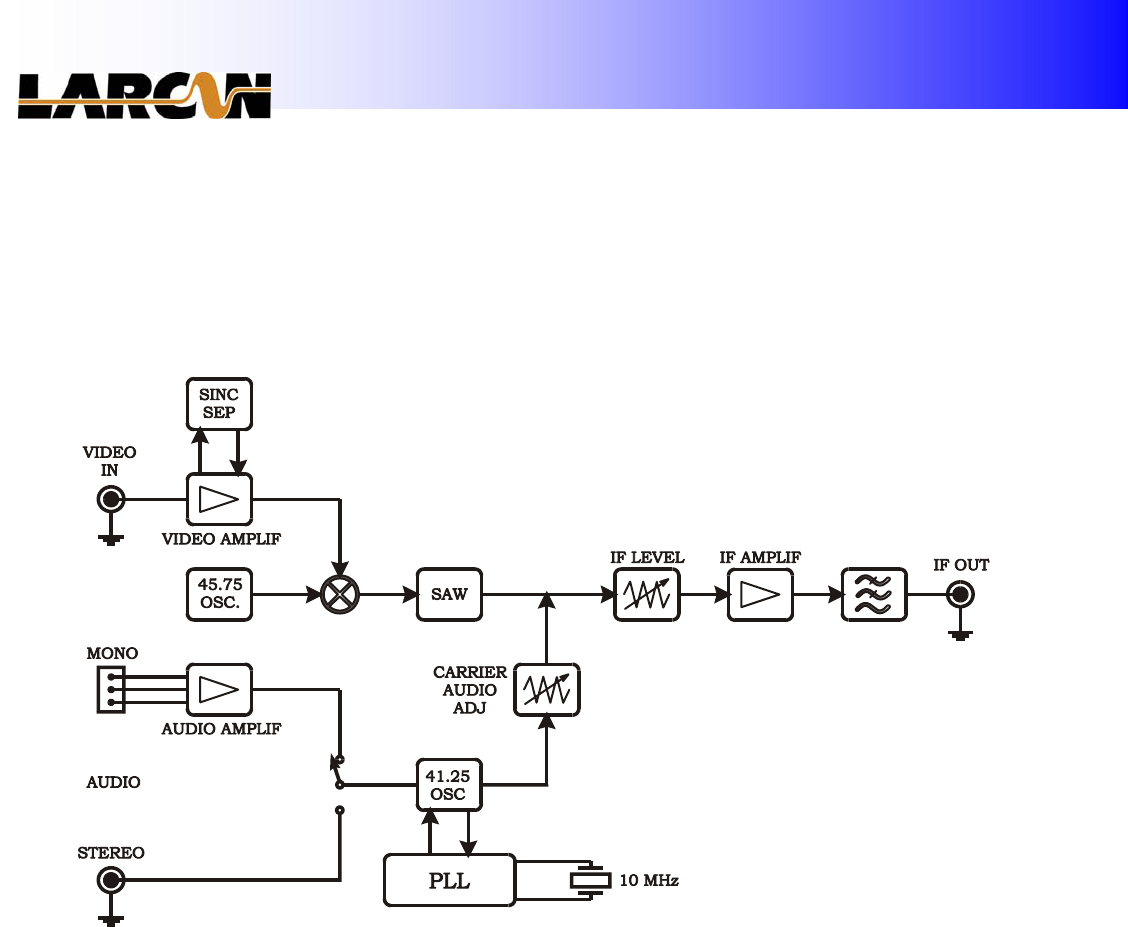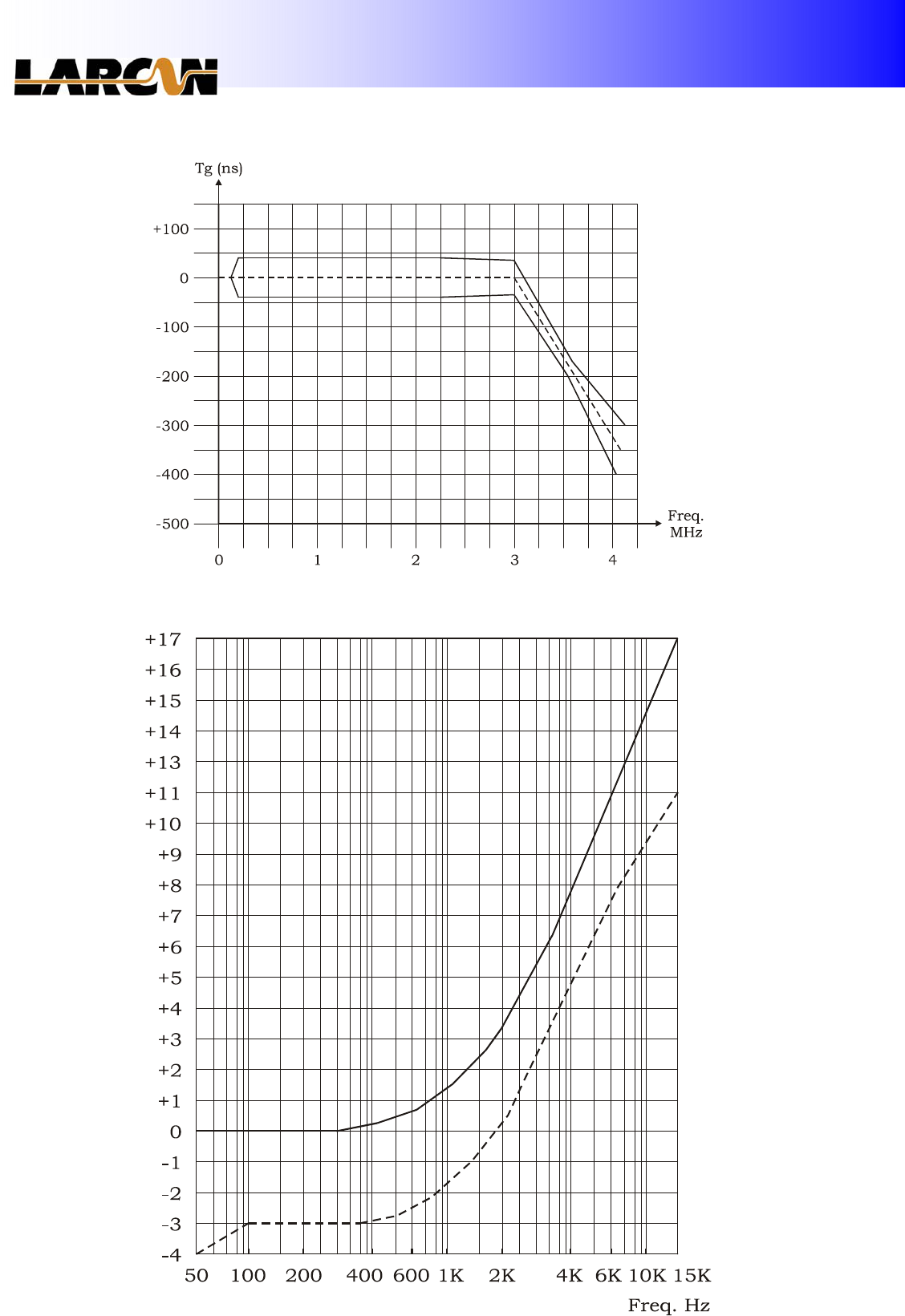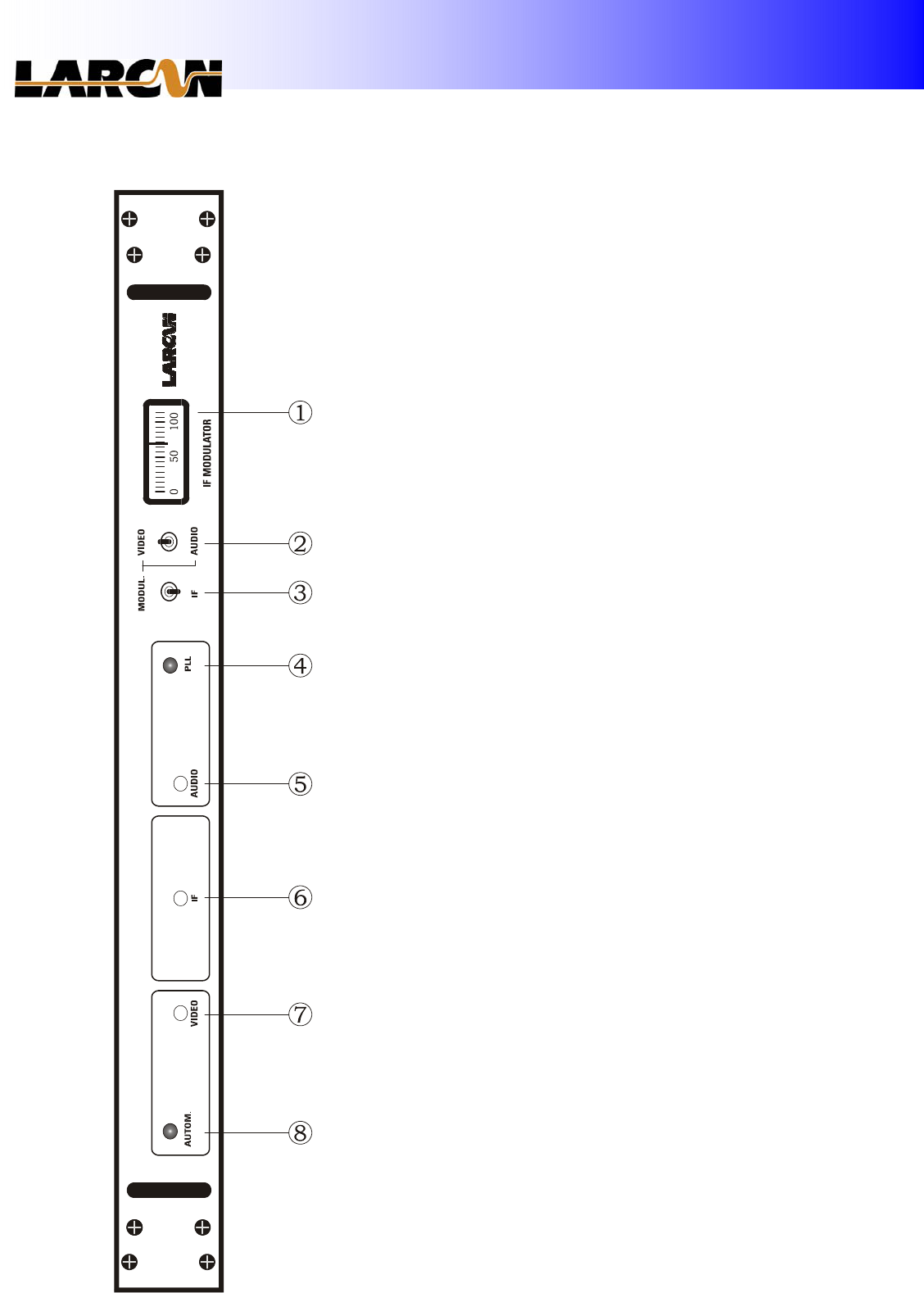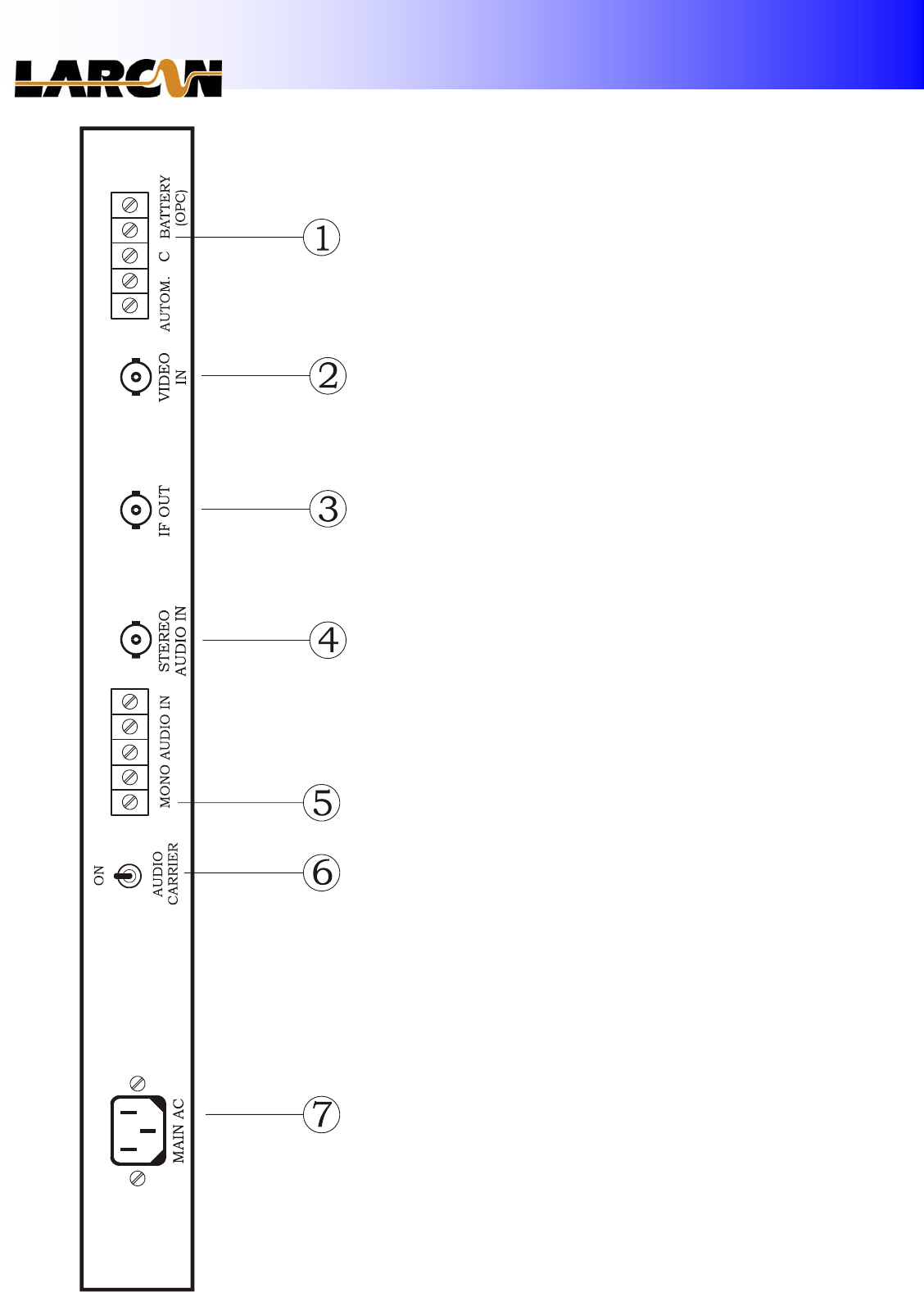Larcan T2500U 2500 Watt UHF Transmitter User Manual RTU5000T
Larcan Inc 2500 Watt UHF Transmitter RTU5000T
Larcan >
Contents
- 1. user manual for tx part1
- 2. user manual for tx part2
- 3. user manual for modulator
user manual for modulator

Unit 2 – IF Modulator
- 1 -

Unit 2 – IF Modulator
- 2 -
1. Audio and Video Modulator:
1.1. Function:
This module function is to generate two carriers: one in 45.75 MHz and the other in 41.25 MHz.
The first is modulated in AM-VSB by a video signal and the other one is modulated in frequency by an
audio signal.
1.2. Block Diagram:
1.3. Technical Description:
1.3.1. Video Modulator:
The transistor Q1 oscillates in the crystal frequency (45.75 MHz - IF video), and the transistor
Q2, with high input impedance, guarantees the isolation to the oscillator Q1 output. The frequency
accuracy is adjusted in the variable inductor L1. The input video signal, with adjustable level in R27
(front panel), is applied to the high impedance input push-pull amplifier formed by transistors Q6 and
Q9. The amplifier output signal modulates in amplitude, in the mixer M1, the video carrier.
The integrated circuits IC18 to IC21 form a group delay predistortion circuit. The syntonized
cells, at the video bandwidth, cause an advancement of 170 ns at 3.58MHz. This video pre-distortion is
inserted in the circuit through jump’s JP5 and JP6. The adjustable attenuator R146 allows equalizing
the video level when the pre-corrector circuit is turned off.
The transistor Q12 receives the video signal, invertes its phase and applies it to the IC7
amplifier. This amplifier causes a non-linear enlargement to the video signal emphasizing the
synchronizing pulses. This signal is clamped in 0.7V by the D5 and is compared to 0.3V (due to diode
D4) in the comparator circuit IC6. In this manner, at the IC6 output, there will be only synchronizing
pulses. These pulses are applied to the IC5 (mono-stable) in the negative transition to generate
clamping pulses. The clamping pulses commute the transistor Q10 that switches the video signal
clamping it to the blanking level through R45. This adjustment allows choosing the point of modulation
in the mixer for a better linearity. If there is lack of clamping pulses, the Q11 transistor commutes,
allowing adjusting through R44 the level of the video carrier without modulation.
The integrated circuit IC9B receives the clamping signal detected through D7, changes its state
and commutes the transistor Q13. It allows switching the external circuits connected to the Automatic
output. The led in the panel shows this operation, when it is green it indicates video on. This circuit
presents about 60 seconds delay time approximately.

Unit 2 – IF Modulator
- 3 -
The video signal peak is detected through IC8 and through IC9 and it is differentiated with the
level adjusted through R45, in order to extract the dc component.
The IC9A output has a dc level related to the video signal not taking into account the
synchronizing pulses. The 100% video measurement is adjusted through R72 in the meter with a video
signal with 100% APL. The C118 e L18 components form an ICPM corrector circuit that allows
correcting a non-desirable phase-shift at the video carrier caused by the modulating signal.
The modulated video carrier is amplified by IC1 and the SAW filter FL1 filters this signal giving
the final characteristics of the desired modulation, i.e., AM_VSB (amplitude modulation with vestigial
side band). The amplifiers IC2, IC3 and IC4 produce the necessary gain to signal, in order to
compensate the losses in SAW filter and deliver a 0 dBm output level. The output signal level is
adjustable by R12 (front panel), which controls the PIN diode conduction (D1). The trimpot R13 limits
the maximum IF output level and the circuit formed by transistor Q19 and capacitor C120 increases
slowly the output level to eliminate high frequency peaks when the equipment is turned on.
The IF signal, after amplification, passes through a low-pass filter, formed by L6, L7, C21, C22
and C23 to eliminate harmonic signals. Part of this signal is sent to the detector circuit formed by
transistors Q3 and Q4 to measure the IF signal in the panel. The trimpot R24 allows adjusting the
reading level through the meter.
1.3.2. Audio Modulator:
The transistor Q14 and associated components generate the audio carrier. The applied voltage
to the varicap diode D10 controls its frequency. The amplifiers IC12 and IC13 increase the signal level
and through the trimpot R108 is applied to the IF amplifier to be delivered at the output. A sample of
this signal is delivered to the “prescaler” IC14 through R108. It divides the signal into 64 and delivers it
to PLL (integrated IC15). The PLL divides again this signal, now into 66, and compares it with a
reference signal in phase, resulting a voltage proportional to the difference of the phase between the
signals; this voltage is filtered and applied to diode D10 to correct the frequency. The reference
frequency for PLL is generated at the integrated circuit itself that oscillates at 10 MHz and divides it
into 1024. The oscillator crystal is found in a thermal chamber, which is controlled by Q15 and by
thermistor NT1, for better frequency stability. The trimmer C90 allows the fine adjustment of this
carrier frequency (41.25 MHz). If the circuit cannot correct the frequency, the transistors Q17 and Q18
are commuted to turn on the frequency error red led.
The audio signal that will cause the modulation in frequency in this carrier may come from the
mono audio input or stereo audio input. It is possible to select it through jump JP3.
The mono audio input circuit has an unbalanced amplifier IC10 and pre-emphasis circuit. It is
possible to turn off the pre-emphasis through jump JP2. The trimpot R92 (front panel) adjusts the
audio level that will cause the correct modulation index. The integrated circuit IC17 and associated
components form a peak detector of audio signal and a trimpot R117 allows adjusting 100% at the
meter for the correct deviation. The battery input (+36V) through D16 and fuse F1 connects through
connector CN2 the power supply FTE017 (optional).
Obs: The circuit diagram is divided into four parts.

Unit 2 – IF Modulator
- 4 -
2. Technical Characteristics:
2.1. General Characteristics:
Operation Temperature: ___________________________________________________________________ 0 to 45°C
AC Power Supply: ________________________________________________________ 220Vca / +36Vcc (optional)
Maximum consuption: __________________________________________________________________________15W
Dimensions: _____________________________________ Height = 44mm; Width = 482.6mm; Depth =
197mm
Weight: _____________________________________________________________________________________ 3.45 Kg
2.2. Video Input:
Impedance: _______________________________________________________________________________ 75 Ohms
Return Loss:___________________________________________________________ > 30 dB (100 KHz to 4.2 MHz)
Level: ____________________________________________________________________________ 1 Vpp (adjustable)
Clamping ___________________________________________________________________________ in the blanking
2.3. Audio input:
Mono:
Impedance: _____________________________________________________________________ 600 Ohms balanced
Level: ___________________________________________________________________________ 0 dBm (Adjustable)
Bandwidth: _________________________________________________________________________________ 15 KHz
Stereo:
Impedance: ___________________________________________________________________ 75 Ohms unbalanced
Level: ___________________________________________________________________________ 0 dBm (Adjustable)
Bandwidth: ________________________________________________________________________________ 100 KHz
2.4. IF Output:
Impedance: _______________________________________________________________________________ 50 Ohms
Return loss: ________________________________________________________________________________ > 23 dB
Level: ________________________________________________________________ 0 dBm maximum. (Adjustable)
Audio/Video carrier ratio: ________________________________________________________ -10 dB (Adjustable)
Harmonics: ________________________________________________________________________________ < -60 dB
2.5. Video Carrier:
Frequency: ______________________________________________________________________________ 45.75 MHz
Modulation: _____________________________________________________________________ 87.5 % (Adjustable)
Frequency response: ___________________________________________________________ according to Mask. 1
Differential gain: _________________________________________________________________________ < +/- 3 %
Differential phase:___________________________________________________________________________ < +/- 2°
Signal to noise ratio: __________________________________________________________ > 60 dB (4.2 MHz BW)
K factor pulse 2 T: __________________________________________________________ < +/- 3 % (vide Mask. 2)
Line tilt: _________________________________________________________________________________ < +/- 2 %
Frame tilt: _______________________________________________________________________________ < +/- 3 %
Chr/Lum. delay: __________________________________________________________ < +/- 25 ns (vide Mask. 3)
Chrom./Luminance Gain: ________________________________________________________________ < +/- 2 %
Synchronizing Pulse Amplitude:___________________________________________________________ < +/- 2 %
Burst Amplitude: _________________________________________________________________________ < +/- 5 %
ICPM: ______________________________________________________________________ < +/- 2 ° (pre-correction)

Unit 2 – IF Modulator
- 5 -
2.6. Audio Carrier:
Frequency: ______________________________________________________________________________ 41.25 MHz
Frequency Stability: ______________________________________________________ 2x 10-6 (Thermal Chamber)
Deviation:___________________________________________________________________ +/- 25 KHz (Adjustable)
Mono:
Pre-emphasis: ___________________________________________________________ 75 µs (according to mask 4)
Freq. response: _________________________________________________________ +/- 0.5 dB (50 Hz to 15 KHz)
Distortion: __________________________________________________________________ < 1 % (50 Hz to 15 KHz)
Signal to Noise Ratio:__________________________________________________________ > 60 dB (1 KHz signal)
Stereo:
Pre-emphasis:____________________________________________________________________________ turned off
Freq. response:________________________________________________________ +/- 0.5 dB (50 Hz to 100 KHz)
Distortion: ________________________________________________________________ < 1 % (50 Hz to 100 KHz)
Signal to Noise Ratio: _________________________________________________________ > 60 dB (signal 1 KHz)

Unit 2 – IF Modulator
- 6 -
3. Reference Mask:
3.1. Frequency Response Mask 1:
3.2 K Factor = 3% Mask 2:

Unit 2 – IF Modulator
- 7 -
3.3. Video Pre-Corrector Mask 3:
3.4. 75µs Pre-Emphasis Audio Response Mask 4:

Unit 2 – IF Modulator
- 8 -

Unit 2 – IF Modulator
- 9 -
4. Frontal and Back Panel:
4.1. Frontal Panel:
Each element in the panel has the
following function:
1. Meter: For video, audio and IF
measurements. For a video signal with 100%
APL the meter will indicate 100%. In the audio
position, the measurement of 100% in the
meter will indicate the correct deviation. In the
IF position, the measurement of 100%
corresponds to 0 dBm level in the output.
2. Video/Audio: Measurement selector
switch. This switch selects the video or audio
modulation index when the switch (IF/modul.)
is in the position (modul.).
3. Modul/IF: Measurement selector
swicth. It selects between the modulation index
or the IF level.
4. PLL: Bicolour led, when it is red
indicates that the Audio carrier is out of
frequency.
5. Audio: Audio level adjustment
through trimpot R92.
6. IF: IF level adjustment through
trimpot R12.
7. Video: Video level adjustment
through trimpot R27.
8. Autom: Bicolour Led, when it is red it
indicates video off, when it is green indicates
video on. It takes about 60 seconds delay time
to change from green to red one.

Unit 2 – IF Modulator
- 10 -
4.2. Back Panel:
Each element in the panel has the
following function:
1. AUTOM, C AND BATTERY (OPC):
- AUTOM: output to external command.
When the video is on, this output is short
circuit to the ground (50mA maximum current).
- C: EXTERNAL CONTROL: Lower output
IF level by ground contact.
- BATTERY (OPC): Battery input +36V
(optional).
2. VIDEO IN: Video input 75 Ohms
impedance (unbalanced) and 1 Vpp level.
3. IF OUT: IF output with 50 Ohms
impedance (unbalanced) and adjustable level.
0dBm Nominal.
4. STEREO AUDIO: Stereo audio input,
75 Ohms impedance (unbalanced), 0dBm level.
5. MONO AUDIO IN: Mono audio input,
600 Ohms impedance (balanced) and 0
dBm/400 Hz level.
6. AUDIO CARRIER: Turn on/off the
audio carrier.
7. MAIN AC: Power supply input 220V.